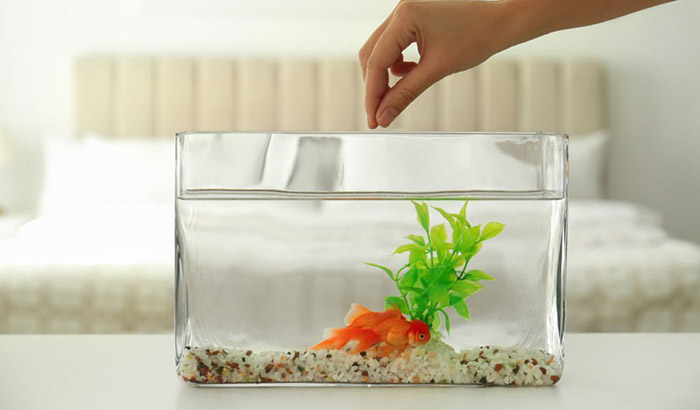When planning to have a fish tank in your home, the most essential factor to consider is the size of the aquarium. There are various fish tank sizes available but highly recommended for newbies are 5 gallons, 10 gallons, and 20 gallons fish tank.
So, what is the difference between the three fish tanks? In this article, we will be comparing 5 gallon vs 10 gallon vs 20 gallon on several factors and what it brings to a prospective fish tank owner once installed in the house.
| Features | 5 Gallon | 10 Gallon | 20 Gallon |
| Size and Weight | Smaller | Bigger | Biggest |
| Fish Quantity | 4 – 6 | 8 – 10 | 10 – 20 |
| Maintenance Difficulty | Easier | Harder | Difficult |
| Price | Cheap | Pricey | Most Expensive |
Size and Weight
The size and the weight are two factors related to each other and determine how big the fish tank is. For a beginner, my recommendation is to go for the smaller size at first which is 5 gallons, because it really fits newbies in terms of their needs and experience.
For a 5-gallon fish tank, the average dimension is about 16” x 8” x 10”, and it is one of the smaller fish tanks available on the market. Its average weight is around 7 lbs when it is empty and approximately 62 lbs when the fish tank is filled with water.
A 10-gallon fish tank only comes in one standard size, the 10-gallon leader. The standard measurement for a 10-gallon fish tank is 20’ x 10” x 12” in size. The weight of this fish tank when empty is 11 lbs and becomes 111 lbs when it is filled with water.
On the other hand, the 20-gallon fish tank is considered the standard size of all the fish tanks. It measures 24” x 12” x 16” and usually weighs 25 found without water. Filing it full of water will make the weight of the fish tank 225 lbs.
The weight indicated above also varies depending on the material being used in the aquarium.
An aquarium made of acrylic materials is usually three to four times lighter compared to glass materials. Then there are also the accessories, filters, plants, and other things you put inside the fish tank, which add to its original weight.
| Feature | 5 Gallon | 10 Gallon | 20 Gallon |
| Dimension | 16” x 8” x 10” | 20” x 10” x 12” | 24” x 12” x 16” |
| Weight When Empty | 7 lbs | 11 lbs | 25 lbs |
| When When Full of Water | 62 lbs | 111 lbs | 225 lbs |
Type of Fish Species
When it comes to owning fish tanks with different sizes, the type of fish you can use on a specific fish tank also varies. The smaller the fish tank you own, the more limitations you have in selecting different species of a fish tank.
5 – Gallon Fish Tank
If you have a 5-gallon fish tank, the number of fish you can put in the aquarium is around 4 to 6 fish. Actually, the general rule when stocking fish in your aquarium is one inch of fish per gallon of water. The recommendation earlier should be ideal for this type of fish tank, especially if you will be breeding smaller fishes. Fish that can grow up to 2 inches is not suitable for this fish tank size.
If you ask me what fish can go in a 5 gallon tank, there are many of them that you can use. The fish species include guppies, betta fish, mollies, cherry shrimp, neon tetras, pygmy corydoras, harlequin rasbora, and neon tetras.
10 – Gallon Fish Tank
If you are using a 10-gallon fish tank, the ideal quantity of fish that you can put is 8 to 10 fish. However, a maximum of 10 must be avoided unless you are stocking small fish together. If you use fish that tends to grow over time, the limit should be around 6 to 8 fish.
If you ask me what fish can live in a 10 gallon tank, there are many species to choose from. You can go for betta fish, guppies, dwarf gourami, golden dwarf barbs, neon tetras, zebra danios, mollies, cardinal tetras, and many more.
20 -Gallon Fish Tank
The 20-gallon fish tank is considered the standard when it comes to the sizing of the aquarium. Most experienced aquarists use this type of tank because the size is enough to stock an ideal quantity of fish.
A 20-gallon fish tank can accommodate 20 1-inch fish or 10 2-inch fish. So, it all depends on the size of the fish you are stocking that determines the quantity you can use in every aquarium. You should also consider the ability of the fish to grow in the future as an added factor when determining the quantity of the fish.
If you ask me what fish can live in a 20 gallon tank, there are many different types of fish that you can stock inside a 20-gallon fish tank. The fish species you can use include swordtail, neon tetra, zebra danio, guppies, catfish, mollies, rasboras, Apistogramma, german blue ram, and many others.
Maintenance Challenges
The bigger the space, the more challenging it is to maintain a fish tank. It is the reason why I will recommend it to those who are just starting to use the smaller size of the fish tank. The cleaning and maintenance requirement is not that difficult compared to those with bigger dimensions.
The maintenance activities you need to do are regular water changes, testing and monitoring water parameters, feeding, and managing light and the aquarium as a whole. All of these activities will be difficult once you are using a bigger type of fish tank.
Price
Another key difference between these types of the fish tank is the price of each. Naturally, the bigger the size, the more expensive it is for its price point. The 20-gallon tank is more expensive compared to the other two, which are smaller.
Conclusion
When comparing 5 gallon vs 10 gallon vs 20 gallon fish tank, it all comes down to what fits your requirements and needs as an aquarist. If you are new, then it is better to settle first with the smallest size. For experienced people, the bigger size works for them perfectly.
Each of the fish tanks requires a varying degree of difficulty when it comes to cleaning and maintaining the fish tank. They also come in different price points, which is an important factor when determining the type of fish tank that will fit you as an aquarist.


